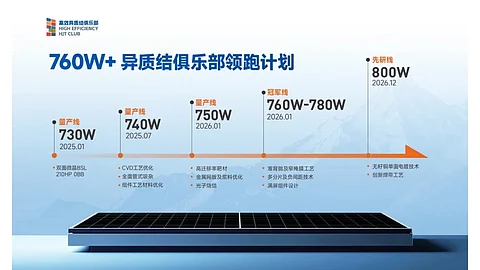

The 760W+ High-Efficiency PV Club is an upgrade from the HJT module makers’ 740 W club launched in 2024
Its technical roadmap targets to exceed 800 W output for HJT modules with 25.75% efficiency
Among the several advancements they target include seedless copper electroplating technology and innovative interconnection solutions
Chinese solar manufacturers of heterojunction (HJT) PV modules, as part of the 760W+ High-Efficiency PV Club, have launched the 760W+ Mass Production Implementation Strategy and Technology Roadmap. This is part of their efforts to advance this cell technology towards higher power and efficiency, exceeding the 800 W mark.
This 760W+ is an upgrade from the 740W+ club founded by 10 Chinese HJT module producers in March 2024, as they called themselves the China Photovoltaic Solar Energy High Efficiency 740W+ Club (see Club For High Efficiency Heterojunction Solar Panels).
“The performance potential of the double-sided microcrystalline structure has not yet been fully released, and there is still room for its efficiency improvement. This is also the underlying technical confidence for the large-scale mass production of 760W+ modules,” said the Chief Scientist of Huasun Energy Wang Wenjing.
Under phase I, HJT 210 mm modules with 730 W output reached 23.5% efficiency. With advancements in module materials, optimization of CVD process and impurity absorption techniques, they increased the power output to 740 W with a module efficiency of 23.8%.
Phase II of the partnership will be further innovative with high-mobility target materials, photon sintering technology, optimizing metal grid designs with paste matching, and adopting a rear passivation process to minimize bifacial ratio loss within 1%. These efforts, they hope, will boost module output to 765 W with conversion efficiency of 24.6% by 2025-end at an upgrade cost not exceeding RMB 20 million ($2.76 million).
Further ahead, their roadmap targets an efficiency of 25.75% and bifacial ratio exceeding 85% by December 2026, with an over 20 W increase in module power that will push the front side power beyond 800 W. “This will be the highest power and efficiency ever achieved on conventional-sized crystalline silicon modules,” stated the companies at their meet recently.
For this, they will explore seedless copper electroplating technology and innovative interconnection solutions.
“When the global photovoltaic industry is caught in a patent melee, heterojunction technology, with its 100% completely independent and controllable technology route, helps Chinese companies avoid patent risks. This is the 'technological ark' of national energy security,” according to Huasun Energy’s Chairman and CEO Xu Xiaohua.
Speaking of technology, on April 10 and 11, 2025, TaiyangNews will hold the TaiyangNews Solar Technology Conference India 2025, an in-person event in New Delhi, India. It will bring together technologists and scientists working on creating a resilient solar manufacturing industry in India. Registrations are open here.
